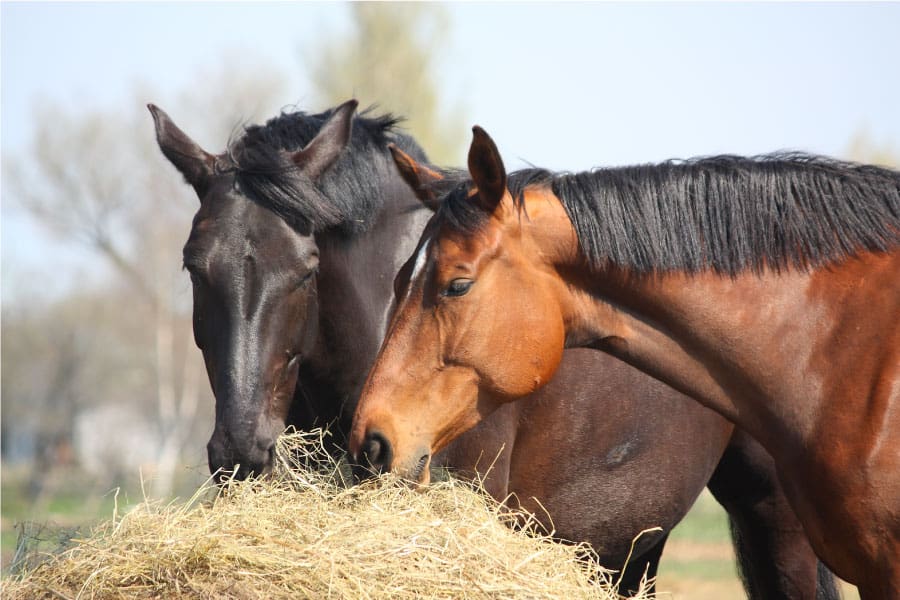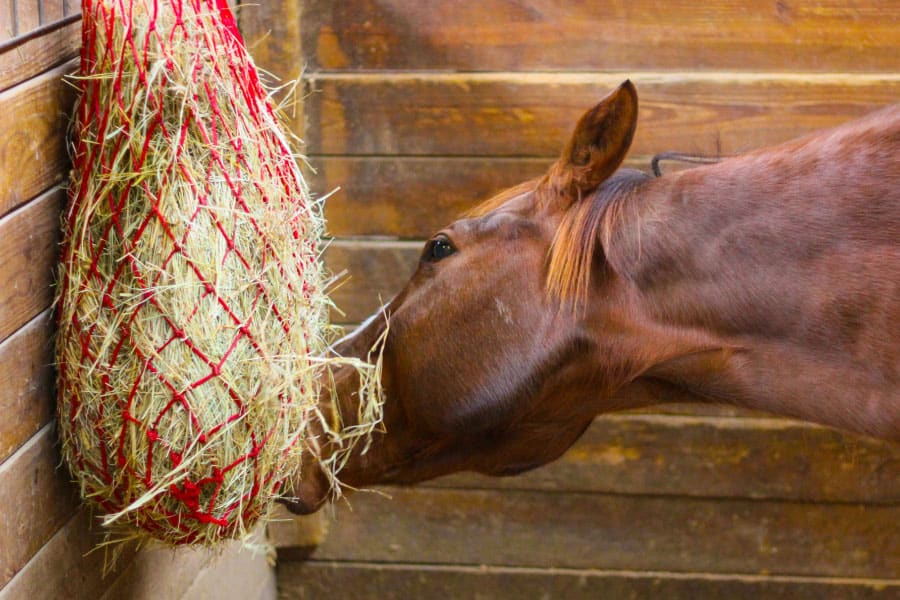
It’s hard to ignore the many positives of feeding a horse the most nutritious diet possible. But just how much nutrition is necessary for horses? And do they get enough from hay or grass?
Horses can live on hay or grass alone. Both provide great sources of carbohydrates, vitamins, protein, and even healthy antioxidants. However, horses do not always get the best possible nutrition from hay or grass alone, so you should supplement their diet with more nutritious foods.
The rest of this article will explain a few topics related to this question in great detail, including what horses need to live, why some horses can’t stay healthy on just hay and grass, and how horses can become as healthy as possible.
What Does a Horse Need to Live?
Access to clean water is the most basic need of horses, with 10 gallons (38 liters) being their average daily consumption. But beyond water, there are many other nutrients horses need in order to survive, each of them important in understanding their feeding habits, and whether a diet of only hay and grass has any real drawbacks.
A folivore naturally adapted to grazing grasses, horses can live on a variety of plant life for their basic survival. After water, there are five more essential categories of nutrients that horses need:
- Carbohydrates
- Protein
- Fats
- Vitamins
- Minerals
Carbohydrates are how horses get most of their energy, and they are consumed both in their structural and non-structural varieties.
When they are digested, structural carbohydrates produce fatty acids that horses can use as energy. Structural carbohydrates also allow horses to more easily regulate their body temperature since breaking them down produces heat.
Non-structural carbohydrates give a horse energy through glucose, and if they consume extra amounts of non-structural carbohydrates, this glucose will then store in a horse’s muscle and liver as glycogen to provide even more energy.
Protein is one of the most important nutrients in keeping horses strong. Turning into amino acids when broken down, they then work with a horse’s body to make new proteins important for hair and hoof growth, as well as muscle.
Fats are another source of energy with many benefits to horses. Being easy on the digestive systems of horses even in high amounts, they also provide energy at a higher level of concentration than other nutrients.
Vitamins are a means of supporting key body functions in horses. Because of this, they are not able to survive without them. In addition to the necessity they serve to body functions, they also help horses get the most benefit out of their food, as vitamins enhance the nutritional impact food has on the body.
Minerals, such as sodium and calcium, are an important part of supporting productivity in horses. Great for nerve and muscle health, minerals also help horses restore electrolyte levels to maintain their energy when they need it most.
The role each of these nutrients play is key to understanding the feeding habits of horses, as well as what diets are best for them to maintain healthy lives.

What Do Horses Need to Eat to Be Considered Healthy?
Hay and grass alone cover so many nutritional needs for horses that only water can match their importance.
Grass, when grazed fresh from a pasture, gives enough energy, fiber, and nutrients to satisfy most of what a horse requires to stay healthy. Horses get plenty of vitamins and antioxidants just from grazing fresh grass, helping to turn their food into energy through digestion.
Even more beneficial, though, are grass and legume hays, eaten as dry forage. On top of having the same nutritional benefits of fresh grass, the high amounts of protein and calcium in grass hay and legume hay make energy-production much easier for horses.
Between fresh grass and hay, horses are provided a level of nutrition that sets them up to live healthy lives.
What Does a Horse Need to Eat for Optimal Health?
For some horses, hay and grass can provide enough nutrition to sustain them well. However, nutritional needs among horses depend on age and level of activity.
For instance, adult horses with less of a workload are less dependent on extra nutrients as a result. On the other hand, younger horses rely much more on protein, as do horses that race and travel, since they need far more energy in their diet to properly grow (in the case of younger horses) or maintain energy levels (in the case of hardworking horses). For these horses, lower-protein diets that work for less active adult horses are not ideal.
So, while it is possible for most horses to live a healthy life with just hay and grass for food, it is true that even better health can be achieved by introducing supplemental nutrients into their diets. Non-structural carbohydrates such as corn, oats, and barley, provide horses with nutrition that is more concentrated in energy.
These grains can be very beneficial to horses and their overall strength when consumed in moderation. But since they are hard for horses to digest, they do not make a good replacement to a horse’s main diet of hay or grass.
The Ideal Feed for Horses
Having explored more about what horses need to live, be healthy, and gain optimal nutrition, it is important to now cover what an ideal daily feed for horses really looks like.
As discussed earlier, nutritional needs among horses will vary depending on age and workload. Here are a few tips for providing horses with varying needs their daily feed:
Senior horses need high-quality protein to make up about 13% of their total diet. Legume hays like alfalfa make the best nutrition for them and can be mixed into their forage accordingly. Canola meal and soybean meal also make a good source of protein to supplement their diet. Feeding with higher fat content and sodium supplements like salt boxes also go a long way in taking care of a horse’s dietary needs.
Adult horses who work less need the least amount of protein in their diets. About 9% of their daily diet should be protein. Grazing fresh grass from pastures is often enough for adult horses who are under less strain to maintain enough nutrition in their diet. In fact, with grass hays providing all the nutrition they need, legume hays are not necessary. Like senior horses, however, sodium supplements like salt boxes are a great addition to the diet of an adult horse.
Hardworking horses like racehorses, show horses, and horses used for a lot of travel, need a minimum of 11% of their daily feed to be protein. This is where non-structural carbohydrates such as corn, oats, and barley are the most helpful, as they give horses the chance to benefit from the feed with very high energy concentration.
Growing horses and lactating mares need protein to be up to 10% of their daily feed. Mixing legume hays like alfalfa into their roughage is the best way to meet those protein requirements.
Conclusion
At a basic level, horses can live on hay or grass alone, since they provide important nutrients.
However, this does not always lead to the best level of health for horses. And on top of that, horses can always benefit from more nutrition, as long as it stays within a safe level of intake.
Therefore, it is important to think beyond just the basics. Consulting an equine veterinarian about your horse’s specific needs is always recommended, and knowing more about how you can help your horse will only make your experience in horse ownership more rewarding.
